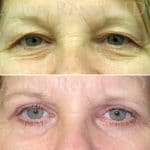Eyes are known to be the “windows to the soul”. Unfortunately, they are also one of the first areas to show signs of ageing which are not easy to hide, and they make you look fatigued and older than you should. Many people tend to make assumptions about a person’s age or the mood they’re in, based on the appearance of their eyes, but many times, these assumptions can be quite erroneous.
As we age, our skin naturally loses some of its elasticity causing a build-up of loose skin around the eyelids that, in the upper lid, can fold over, producing a hooded effect. In the lower lid, the effect may be deepening furrows or creases. Advancing years also result in a weakening of the muscles in our face, including around the eyes. This can encourage the fat that naturally sits around the eye, protecting, and cushioning it, to protrude through the weak muscle, producing even larger eye-bags.
Eyelid Surgery, also known as Blepharoplasty, removes excess skin, muscle and sometimes fat from the upper and/or lower eyelids for a more energetic, brighter, and youthful appearance. In this blog, Mr Allen Rezai, Consultant Plastic, Aesthetic & Reconstructive Surgeon of Harley Street, London recommends five things you should know about eyelid surgery, but it does not replace the necessity of a one to one, thorough consultation with a qualified and experienced surgeon, as it is only then you can decide whether surgery is right for you. Having more information and a clear expectation about what’s next will help you make an informed decision and to better manage your post-op recovery so that you have the best possible experience out of your surgery.
Before & after photo
To view before and after photos, please refer to the gallery page: Blepheroplasty/Eyelid Surgery Before & After Photos
1. What are the Indications for Eyelid Surgery

Indications for Eyelid surgery include:
- Puffiness in the upper eyelids caused by excess fatty deposits
- Loose or sagging skin that creates folds or disturbs the natural contour of the upper eyelid, sometimes impairing vision
- Excess skin and fine wrinkles of the lower eyelid
- Bags under the eyes
- Droopiness of the lower eyelids
Before deciding to undergo surgery, it is important to determine the underlying issues causing the concerns you have with your eyes. Sometimes it may be due to a medical condition or it might not even be your eyelids causing the problem, thus requiring another type of treatment. For example, the sagging of eyebrows can sometimes be the root of droopy upper lids, rather than the lids themselves and this should be addressed with a lateral brow lift and not an eyelid surgery.
Thorough consultation and assessment with a qualified and experienced surgeon is necessary to determine your suitability for surgery and to also discuss all the implications of the procedure including the possible risks and complications.
2. Cosmetic vs. Functional Blepharoplasty / Eyelid Surgery

Indications for eyelid surgery are droopy or baggy eyelids, excess hooded skin, weak, loose muscle, and bulgy fat pockets. These are usually caused by ageing but sometimes may be hereditary and appear prematurely.
The above symptoms may result in both cosmetic and functional concerns, which can be addressed with Blepharoplasty or Eyelid Surgery. Cosmetic eyelid surgery refers to the procedure, when it is not medically necessary and is performed solely to improve the aesthetic appearance of the eyes. Whereas a functional eyelid surgery, refers to the procedure, when it is performed for medical reasons. In most cases, a functional eyelid surgery is performed to remove loose skin from the upper eyelid if it droops low enough to impair one’s vision for driving or other visual activities. Other problems addressed with functional eyelid surgery are:
- Baggy upper or lower eyelids causing difficulty wearing glasses or contact lenses
- Excess folds of eyelid skin rubbing together causing Irritation
- Forehead discomfort from overused muscles that strain to lift sagging skin in the eyelid area.
Functional Eyelid Surgery is normally covered by insurance whereas Cosmetic Eyelid Surgery is not.
3. Different Blepharoplasty / Eyelid Surgery Techniques

Advances in eyelid surgery has allowed patients to have the surgery with little to no visible scars at all. By making incisions in the natural creases of the upper and lower eyelids, surgeons are able to keep most scars from being visible to others. Depending on the severity of the condition of the eyes, different techniques are used in Eyelid surgery.
In the upper eyelids, excess skin and fat can create a heavy looking eyelid, aged appearance, puffiness, and sometimes even block vision. An upper eyelid surgery uses incisions on the skin to allow for removal of excess skin and fat and sometimes tightening of the eyelid to correct droopiness or sagging. A thin suture is then used to bring the skin together allowing for the creation of an eyelid crease.
Lower eyelid surgery can involve skin incisions directly below the lash line or an incision on the inside of the lower eyelid, known as a transconjunctival approach. The transconjunctival technique is usually performed on patients with small bags under their eyes (i.e. no excess skin). The fat can be removed through an incision in the interior of the lower lid, while keeping the patient from having a visible scar.
There is also a technique known as double eyelid surgery, which is performed most commonly on Asian patients to create a crease in the upper eyelid. It is often used to create a more Caucasian look in the patient.
4. Recovery Can Take Up to a Few Weeks but Results Are Long-Lasting

Immediately after eyelid surgery, patients may experience, discomfort, mild pain, swelling, bruising, and possibly vision changes. The pain and blurriness usually subside within a few days and depending of the extent of surgery, most patients return to work and normal activity within couple of weeks. Swelling and bruising can take longer to resolve. Patients are provided with comprehensive pre-and post treatment instructions and regular follow ups are required.
For the majority of patients, the result of eyelid surgery is long lasting and many times permanent, however, it will not stop ageing and of course, the younger a patient undergoes surgery, the more likely it is that a further eye surgery may be needed further down the line. The person’s heredity along with external factors and lifestyle, play a big role in how the person ages. Avoiding sun exposure, reducing stress, limiting one’s smoking and drinking will help to maintain the youthful look of the eyes for longer.
5. Non-surgical Alternatives and Combination Treatments

There are non-surgical options for treating sagging and puffy eyelids depending on the extent of the condition. These options are mainly for individuals who are not yet ready or do not have the indications for surgery. Injectable fillers or PRF may be used to reduce the hollow appearance or dark circles beneath the lower eyelids, while muscle relaxing injections can improve the appearance of the upper eyelids by creating a lift to the lateral side of the eyebrows. However, it should be noted that these treatments are not permanent and do not remove excess skin, but they may improve the look of subtle changes on the eyelids.
It is important to understand that Eyelid surgery will not change the basic structure of one’s eyes and it is not a reconstructive procedure. It won’t correct sagging eyebrows, asymmetry, or crow’s feet wrinkles. To achieve one’s aesthetic goals, sometimes, it is necessary to combine the eyelid surgery with a browlift, facelift or non-surgical procedures. Your suitability for treatment, whether it being surgical or non-surgical can only be determined following a through consultation and assessment.
To conclude, we asked Mr Rezai to provide a list of what he believes to be the most important considerations to be taken into account when contemplating surgery and choosing a surgeon. The following was his reply in the form of a simple but comprehensive check-list:







